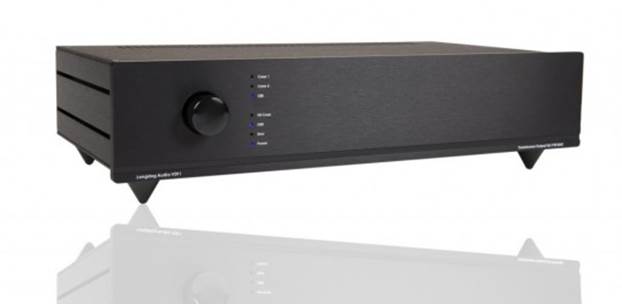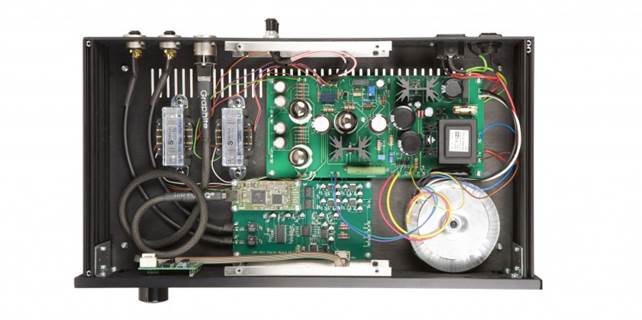Longdog Audio’s VDt1 is a minimalist high-end DAC with a
difference, but is it the mutt’s nuts?
These days, $5,626.3 gives you a choice of a good range of
feature-laden DACs and digital preamps. Kitted out with fancy displays,
multifarious features and often with streaming functionality too, they seem to
have more inputs than you’d see in a recording studio desk. And then there’s
Longdog’s VDt1, which is the diametrical opposite. The objective of this
stripped-down, minimalist machine is – in the words of designer Nick Gorham –
to be a digital convertor that “plays PCM as well as it can”.

Longdog Audio VDt1
It also gives Direct Stream Digital playback, too – DSD 64
only, 128 isn’t supported. And so, at the Longdog’s heart is a Japanese-sourced
and uncommon Asahi Kasei AK4396 DAC chip, chosen because in Nick’s view it was
the best sounding around for his intended application. It does the digital
filtering internally, with no additional output filtering after the analogue
stage, other than that provided by the output transformers.
Unusually, the analogue board sports two JAN Philips 5687
triode valves and because they are robust and have very close matching between
them. They are very long life tubes and to aid longevity there’s an automatic
standby feature, which powers off the output stage after a period of non-use.
The system shuts down the heater supply and HT for the valves if it sees
digital silence for more than five minutes and turns the normally blue power
LED to a flashing red color; the DAC circuitry is powered up all the time
unless the mains power is turned off at the back.
Three regulated power supplies are provided, for the digital
board main supply, output stage valve heater supply and valve-regulated high
voltage supply using high voltage MOSFETs and EF86 pentode. The low noise HT
supply ensures a low analogue noise floor, Longdog says, and the DAC itself is fed
by two ultra-low noise voltage regulators. The I2S and DSD inputs are isolated
from the receiver to avoid noise transfer between stages. The digital board has
four stages of pre-regulation using low-noise regulators, nine of which are
mounted beside the driven device. The custom board design provides isolated
ground paths between stages, and a steroidal transformer completes the picture.

It also gives
Direct Stream Digital playback, too – DSD 64 only, 128 isn’t supported
Real effort has been taken to minimize the transmission of
noise; both from outside and that which is generated inside. High-quality
rocketry is apparent on the back panel, and the digital inputs are galvanic
ally isolated with pulse transformers – a great boon considering the rubbish that
can come down a USB lead from a computer. The S/PDIF receiver is supplied by
three separate ultra-low noise voltage regulators, the designer says, and
Tellurium Q Graphite USB cable is used inside. Mechanical noise is reduced by
the solid casework that’s supported by RDC cone feet, and the casing and base
is all aluminum to avoid the generation of earth current loops in the
metalwork, both from external fields and internally.
This DAC is well made; the manufacturer has obviously taken
great care to produce a finely finished product both inside and out. The front
panel knob selects between three inputs (two coaxial and one USB) and there’s a
bank of handy LEDs to indicate power, error condition, DSD and HS Coax (which
lights when the coaxial input sees 88.2kHz sample rates or higher). I would
have liked to have seen an additional way of displaying that 176.4 kHz or
higher has been achieved too – and make this apply to the USB input, just to
make life that little bit more certain. As any computer audiophile knows, one
cannot always be completely sure what you’ve actually got going out of your
computer! Still, it works well as it is and doesn’t have a cluttered fascia,
which is no bad thing. A choice of black or silver front panels is offered,
although the case remains black whichever variant you specify.

The stripped down,
minimalist Longdog proves that less is more
The Longdog will work at the usual 16-bit/44.1kHz to
24-bit/192kHz resolution; it will accept 32-bit signals, but won’t process
them. The USB 2 interface requires no drivers for Linux and Mac users, while
there’s a simple driver installation procedure for Windows devotees. It
supports DSD over USB, 64-bit DSD and has automatic switching between PCM and
DSD. Either of its two coaxial digital input sockets can be repurposed as
Toslink or AES XLR inputs to special order, or the RCA audio outputs changed
for XLRs. With my MacBook Pro, the Longdog hooks up with no messing, and works
seamlessly with my Audirvana Plus hi-res software player; I also use an
Audiolab 8200CD CD player for optical disc transport purposes.